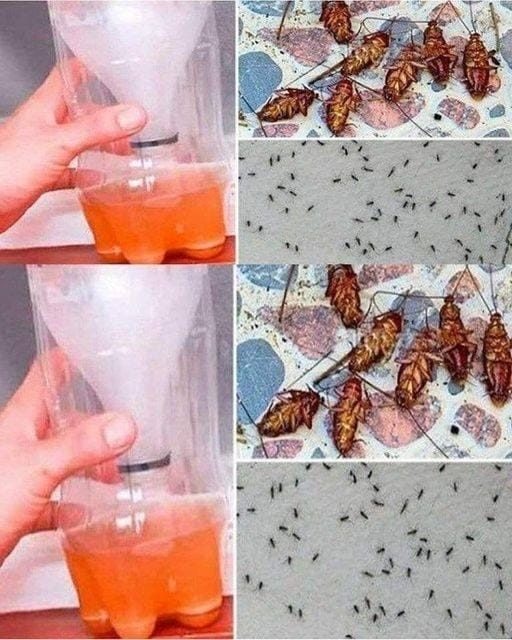ADVERTISEMENT
—
### The Recipe: All-Natural Mosquito and Cockroach Repellent
This homemade pest control recipe uses a combination of essential oils and common household ingredients to keep both mosquitoes and cockroaches at bay. The strong scents of certain oils act as natural deterrents, while other ingredients disrupt the pests’ sensory systems, making it harder for them to find food and water sources.
#### Ingredients:
– 1 cup of water
– 1/2 cup of white vinegar
– 10 drops of peppermint essential oil
– 10 drops of tea tree oil
– 10 drops of eucalyptus essential oil
– 1 tablespoon of dish soap (to help the oils mix with water)
#### Equipment:
– A spray bottle (preferably glass, as essential oils can break down plastic over time)
– A funnel (optional)
—
### How to Make the Homemade Pest Repellent
1. **Prepare the Bottle**
Start by getting your spray bottle ready. A 16-ounce spray bottle should be sufficient for this recipe. If you’re using a larger bottle, simply double the ingredients.
2. **Mix the Ingredients**
Add 1 cup of water and 1/2 cup of white vinegar to the spray bottle. Vinegar is a great natural cleanser that also helps repel cockroaches, as they dislike the strong smell. Vinegar’s acidity also makes it an effective cleaner for areas where pests might be hiding.
3. **Add Essential Oils**
Next, add 10 drops each of peppermint, tea tree, and eucalyptus essential oils. These oils are powerful natural repellents for mosquitoes and cockroaches. The strong minty aroma of peppermint is particularly effective against mosquitoes, while tea tree oil has insecticidal properties that target cockroaches and other pests.
4. **Add Dish Soap**
Add 1 tablespoon of dish soap to the bottle. The dish soap helps emulsify the oils, ensuring they mix with the water rather than floating on top. It also helps break down the waxy coating of cockroaches, making it harder for them to survive.
5. **Shake Well**
After adding all the ingredients, secure the spray bottle lid and shake well to mix everything. The oils may separate from the water over time, so give the bottle a good shake before each use.
—
### How to Use the Homemade Pest Repellent
– **For Mosquitoes**:
Spray the solution around windows, doors, and other entry points where mosquitoes are likely to come in. You can also spray it directly on your skin (though do a small patch test first to check for any skin sensitivities). Additionally, spray the solution around any areas where mosquitoes tend to gather, such as patios or outdoor furniture.
– **For Cockroaches**:
Spray the solution in areas where you’ve noticed cockroach activity, such as cracks in the walls, under the sink, and around garbage cans. Be sure to spray the solution directly on the cockroaches or their hiding spots to make it more effective. It works as both a repellent and a contact insecticide.
– **As a Preventative**:
Use this spray regularly in areas prone to pests, such as kitchens, bathrooms, and entryways. Reapply as needed, especially after cleaning, as this solution can lose its effectiveness over time due to evaporation.
—
### Why This Recipe Works
– **Peppermint Oil**: Known for its strong, minty scent, peppermint oil is a powerful mosquito repellent. The strong odor disrupts mosquitoes’ sensory systems, making it difficult for them to find humans and animals to bite. Peppermint oil is also a great cockroach deterrent.
– **Tea Tree Oil**: Tea tree oil is not only effective against mosquitoes, but it also has insecticidal properties that make it a fantastic repellent for cockroaches and other pests. It works by attacking pests’ nervous systems and reducing their ability to function properly.
– **Eucalyptus Oil**: The aroma of eucalyptus oil acts as a barrier to both mosquitoes and cockroaches. It’s particularly effective at repelling mosquitoes because of its strong, sharp smell.
– **White Vinegar**: Vinegar is a natural cleaner and deodorizer, making it a great addition to this recipe. It also disrupts the environments where cockroaches thrive, such as kitchens and bathrooms.
– **Dish Soap**: Dish soap helps mix the oils with the water, ensuring an even application. Additionally, it breaks down the waxy protective layer on cockroaches, making them more vulnerable to the oils.
—
### Tips for Effective Use
– **Use Regularly**: For long-term pest control, make sure to use this spray consistently. Pest issues are rarely solved with one application, so be sure to spray in the right spots at least once a week for prevention.
– **Reapply After Cleaning**: Since this spray can lose its potency with cleaning or rain, it’s essential to reapply the solution after you’ve cleaned the area or if you’ve had a rainstorm (if using it outdoors).
– **Safe Around Pets and Children**: This homemade pest solution is made with non-toxic ingredients, making it safer than traditional chemical sprays. However, as with all essential oils, use caution around pets—especially cats—since some essential oils can be harmful to them. Always make sure the spray has dried before allowing your pets to come into contact with sprayed areas.
—
### Final Thoughts
Say goodbye to mosquitoes and cockroaches with this powerful, natural, and homemade pest control recipe. By using simple ingredients like essential oils, vinegar, and dish soap, you can create an effective solution that keeps your home pest-free without relying on harmful chemicals. This easy-to-make spray can be customized with your favorite oils, so you can tailor the scent and potency to your needs.
So, why not give it a try? This natural, homemade recipe will not only help protect your home but will also leave it smelling fresh and clean. Keep those pests at bay, and enjoy a comfortable, chemical-free living space!
—
Have you tried this natural pest repellent before, or do you have any other tips for keeping pests at bay? Let me know in the comments!
ADVERTISEMENT
